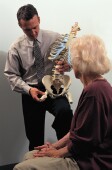
TUESDAY, Jan. 28, 2014 (HealthDay News) — Spinal cord injury rates in the United States are rising, and the leading cause now appears to be falls suffered by seniors rather than traffic crashes, according to a new study.
The findings suggest that programs to prevent falls in elderly people could significantly reduce the number of spinal injuries in the nation, the researchers said.
They analyzed data from more than 43,000 adults with spinal cord injuries who were treated in hospital emergency rooms between 2007 and 2009. The incidence rate among people aged 18 to 64 dipped from about 52 people per million in 2007 to about 50 per million in 2009, according to a Johns Hopkins Medicine news release.
The rate of spinal injuries among people 65 and older rose from about 79 people per million to nearly 88 per million during that time, according to the study, which was published in the Jan. 23 issue of the Journal of Neurotrauma.
“We are seeing a changing face in the epidemiology of spinal cord injury,” study co-leader Dr. Edward Hammond, a research associate at the International Center for Spinal Cord Injury at the Kennedy Krieger Institute in Baltimore, said in the news release.
Falls accounted for 41.5 percent of spinal cord injuries during the study period, followed by traffic crashes at 35.5 percent. The researchers also found that fall-related spinal cord injuries accounted for 30 percent of all injuries among seniors in 2009, compared to 23.6 percent in 2007.
A previous study found that the average age of adults with spinal cord injuries was 41 between 2000 and 2005. It was 51 in the current study, according to the news release.
The researchers also found that seniors with spinal cord injuries are four times more likely than younger patients to die from those injuries in the emergency room. Older patients also are six times more likely to die after being admitted to the hospital with a spinal injury.
The precise reason spinal cord injuries are more likely to be caused by falls than traffic crashes is unclear, the researchers said. It might be a combination of the overall aging of the U.S. population, the more active lifestyles of seniors and increased crash protection provided by airbags and seatbelt laws, they said.
The researchers also found that spinal cord injuries are a growing financial burden on the health care system. From 2007 to 2009, emergency-room charges alone for spinal cord injuries totaled $1.6 billion. Those charges increased 20 percent over the study period — well above the rate of inflation, they said.
“We have demonstrated how costly traumatic spinal cord injury is and how lethal and disabling it can be among older people,” study co-leader Dr. Shalini Selvarajah, a postdoctoral surgical research fellow at the Johns Hopkins University School of Medicine, said in the news release. “It’s an area that is ripe for prevention.”
More information
The U.S. National Library of Medicine has more about spinal cord injuries.
Copyright © 2025 HealthDay. All rights reserved.

